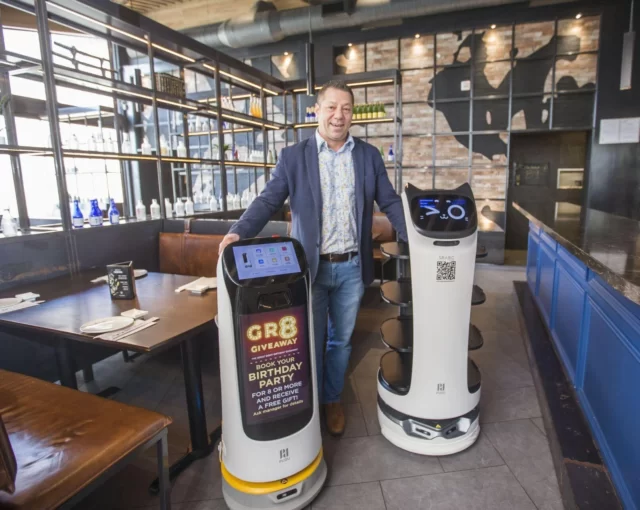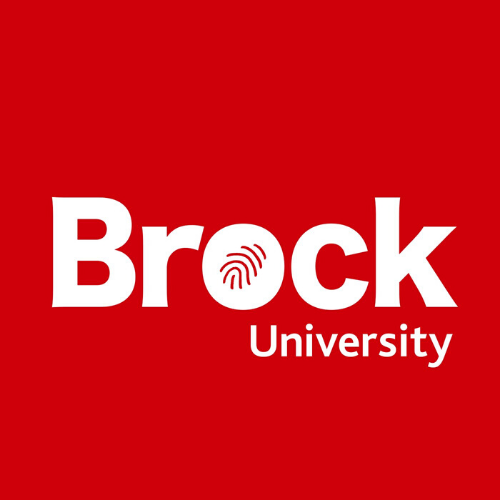
The Wind Group of Restaurants uses robots in several of its establishments in Niagara, including Wind and East Izakaya in Niagara Falls. In the photo with the two robots that take patrons to their tables and brings plates of food out to customers at East Izakaya, is chief executive officer Shane Connolly. Bob Tymczyszyn St. Catharines Standard
They glide quietly and efficiently between tables and restaurant guests stacked with meals for hungry patrons. While not much for conversation, they have been known to produce a charming rendition of “Happy Birthday” when called upon.
Robot servers: Are they good or bad for the restaurant labour market?
It depends who you ask.
Coming out of the COVID-19 pandemic, with increasing reports about challenges in hiring and retaining staff, proponents of mechanized servers say they can complement humans, who remain absolutely necessary.
But others caution the programmed servers on wheels can represent the thin edge of the wedge and could create undesirable outcomes down the road.

Paul Gray is an associate professor of labour studies at Brock University.
Paul Gray, an associate professor of labour studies at Brock University, said a lot of fears around automation historically concerned manufacturing, but more recently have shifted to “labour office work.”
“Traditionally, it was thought that the more hospitality, service sector jobs would be a bit more insulated from automation and its more recent form, AI, because there’s a person-to-person interaction that you can’t replicate with technology,” he said.
“Nevertheless, we are, I think, seeing the use of technology, a kind of automation, more and more in the hospitality sector, in the restaurant industry and the service sector in general.”

This photo shows one of two robot servers at East Izakaya restaurant in Niagara Falls.Bob Tymczyszyn St. Catharines Standard
The Wind Group of Restaurants runs several Asian establishments in Niagara, including Wind and East Izakaya in Niagara Falls.
During the COVID-19 pandemic, it decided to leap into the robot age. Since 2021, robots have complemented human staff, one to take patrons to tables and the other bringing plates out to customers.
It has allowed servers to spend more time with guests, providing a better experience, said chief executive officer Shane Connolly.
He said it relieves strain on staff having to carry heavy trays from the kitchen, which can take a physical toll on servers over time, especially at all-you-can-eat establishments where one table could order dozens of plates of food.
Connolly is quick to point out the robots, which were provided by Sparc Technologies, have not replaced any humans, and stressed there are no plans to do so.
In fact, the robots cannot replace humans as they do not have arms, meaning they cannot, for example, clean tables.
“It doesn’t actually take away any labour, it actually enhances the experience,” said Connolly.
“This robot can deliver food to like five different tables at once, where a human, if they carried (food to) five different tables at once, they would be overloaded, possibly breaking (dishes), falling, or sore arms, or they just can’t do it and they have to make multiple trips. But now they stay in their section and these robots come out and they stop in a certain area, or at the table, and they just go to the robot, get the food and they can talk to the table more.”

Dolores Fabiano is executive director of South Niagara Chambers of Commerce.
Dolores Fabiano, executive director of South Niagara Chambers of Commerce, said the workforce continues to be the No. 1 issue across all sectors.
“Workforce has been an issue for a number of years … just being able to find people to do the work and being able to afford people,” she said.
“What we were paying pre-pandemic is not what we’re paying today. Those labour costs have really increased, and there’s not enough people. I’m sure you’ve noticed that your favourite restaurant is not open six days a week, not open five days a week, a lot of them aren’t even open four days a week and that all has to do with workforce, so bringing in some robotics to help, to augment, I think is great, I get why that would happen.”
At the same time, Fabiano said, “we do want to protect jobs. We want people to be able to earn a living in our communities. I can see the opportunities for it to assist and augment, but it’s a fine line.”
There are several robots in the market, however the Canadian market is only about four years old, said Greg Staley, general manager of E-Pro Bot, an importer and national distributor of Keenon robots in Canada.
Keenon started in 2010 and has deployed more than 35,000 robots worldwide, he said.

This is a photo showing a Keenon brand robot, which was introduced in 2010 and has deployed more than 35,000 robots worldwide, including to a couple restaurants in Niagara Falls through its importer and national distributor in Canada, E-Pro Bot.
Staley said his company has provided robots to a couple of restaurants in Niagara Falls, including the Mandarin.
“It is only a server’s assistant and not a robot that will replace staff,” he said.
“Canada still faces a major job shortage since COVID in the hospitality industry. Robots, simply, are assistants that lessen the work load.”
“In other locations such as senior homes, helping staff remain on the job while paying better attention to residents is our focus. Helping reduce injury due to continued carrying, burnout and stress is critical to keeping staff on the job.”
Staley said robots can be programmed to play songs, such as “Happy Birthday,” for a party table.
“This creates a lot of excitement, especially with the children. These experiences are often recorded and put online which drives even more traffic to the location, which means job security as a busier restaurant means more staff not less.”
But what if in the future as technology continues to evolve, restaurants start using robots with arms that can replicate more, or most, of what human servers do?
That’s a concern held by Mike Ward, a regional representative with Workers United Canada Council, a union representing up to 700 workers in Niagara, including those in the hotel, hospitality and tourism industry.
He said the labour movement “needs to keep a close watch” on how employers utilize robots.
“I get the concept that they are currently a novelty item for some diners, something different, innovative and futuristic,” he said.
“However, there is a significant concern that we may lose these (food and beverage) jobs to robots,” said Ward, adding many people in Niagara experience the food and beverage industry as a first job.
“Replacing some of those positions with robots is going to negatively impact a young person’s opportunity to find work. Serving jobs as a whole have provided several people with the opportunity to earn a living when maybe there were no other options for work.”
He said employees who fear their employers are looking to add a robot server or more “should consider what their workplace is going to look like in five or 10 years.”
“If you believe that your job will be in jeopardy and you are going to be replaced by a robot, you should contact a local union and at the very least have the conversation about how they might be able to help.”
Fabiano said she’s glad to hear how restaurants in Niagara are currently using robots.
“It’s relieving some of the pressure. I could see how families might want to go check it out because, wow, this is something different. Good on them, they should market it that way.”
Gray from Brock said continued use of robots does raise questions.
“There have been hotel unions, for example, which as part of their bargaining demands have gone on strike over issues of automation in the hotel sector and wanting to get some job protections,” he said.
Gray said there have been examples where technology has replaced workers and raised fears of if it being used to “surveil” workers.
But, he said, what more typically happens is it doesn’t replace work, but rather “augments it.”
“It can also create more work, or different kinds of jobs,” said Gray.
“A good example is ATMs. When they were first being developed, people thought that, ‘well, this is the end of bank teller work,’ and actually there are more bank tellers now than there were prior to the existence of ATMs, in part because technology has led to an expansion of financial services and the ways in which people engage with their banks.”
He said it’s difficult to predict what this will mean for the future in the restaurant industry.
“Technology is created by human beings and it often reflects the relationships that human beings have, the biases that we have, the power and balances between us. Typically what has needed to occur is there being a kind of combination of legislative regulation of work and work processes and workers coming together and organizing to ensure that they have a voice in what is implemented and how it’s implemented.”
“Technology is created by human beings and it often reflects the relationships that human beings have, the biases that we have, the power and balances between us.”
Paul Gray, Brock University
Fabiano said as the chamber builds its agenda for an upcoming Niagara Networks and Industry Collaborative initiative, understanding AI is “one topic across all sectors that keeps popping up.”
“They want to understand AI better, they want to look at what opportunities are potentially there for their sector, and people are also nervous about it.”
As for the Wind Group of Restaurants, Connolly said the company is “all about service” to its customers, adding human-to-human interaction remains essential.
“If you go to our restaurants and you see how robots interact, you’ll never really interact directly with the robot. You might take the food off, but a server will always be around.”

